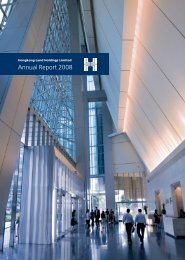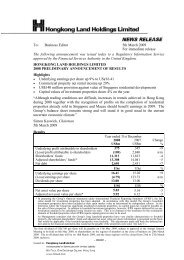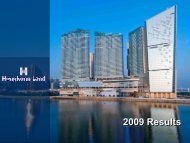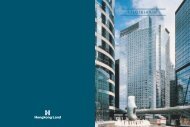Annual Report 2011 - Hongkong Land
Annual Report 2011 - Hongkong Land
Annual Report 2011 - Hongkong Land
You also want an ePaper? Increase the reach of your titles
YUMPU automatically turns print PDFs into web optimized ePapers that Google loves.
1 Principal Accounting Policies continued<br />
Tangible fixed assets and depreciation<br />
Depreciation of tangible fixed assets is calculated on the straight line basis to allocate the cost or valuation of each asset to<br />
its residual value over its estimated useful life. The residual values and useful lives are reviewed at each balance sheet date.<br />
The estimated useful lives are as follows:<br />
Furniture, equipment and motor vehicles<br />
3 – 10 years<br />
Where the carrying amount of a tangible fixed asset is greater than its estimated recoverable amount, it is written down<br />
immediately to its recoverable amount.<br />
The profit or loss on disposal of tangible fixed assets is recognised by reference to their carrying amount.<br />
Investment properties<br />
Properties including those under operating leases which are held for long-term rental yields or capital gains are classified and<br />
accounted for as investment properties, but the business model does not necessarily envisage that the properties will be held<br />
for their entire useful life. Investment properties are carried at fair value, representing estimated open market value determined<br />
annually by independent qualified valuers who have recent experience in the location and category of the investment property<br />
being valued. The market value of each property is calculated on the discounted net rental income allowing for reversionary<br />
potential. Changes in fair value are recognised in profit and loss.<br />
Investments<br />
i) Investments are classified by management as available for sale or held to maturity on initial recognition. Available-for-sale<br />
investments are shown at fair value. Gains and losses arising from changes in the fair value are recognised in other<br />
comprehensive income. On the disposal of an investment or when an investment is determined to be impaired, the<br />
cumulative gain or loss previously deferred in equity is recognised in profit and loss. Held-to-maturity investments are<br />
shown at amortised cost. Investments are classified under non-current assets unless they are expected to be realised<br />
within twelve months after the balance sheet date.<br />
ii)<br />
At each balance sheet date, the Group assesses whether there is objective evidence that an investment is impaired.<br />
In the case of equity securities classified as available for sale, a significant or prolonged decline in the fair value of the<br />
security below its cost is considered as an indicator that the securities are impaired.<br />
iii) All purchases and sales of investments are recognised on the trade date, which is the date that the Group commits to<br />
purchase or sell the investment.<br />
Leases<br />
Leases are classified as finance leases when the terms of the lease transfer substantially all the risks and rewards of ownership<br />
to the lessee. All other leases are classified as operating leases.<br />
Properties for sale<br />
Properties for sale, which comprise land and buildings held for resale, are stated at the lower of cost and net realisable value.<br />
The cost of properties for sale comprises land cost, and construction and other development costs.<br />
Debtors<br />
Debtors, excluding derivative financial instruments, are measured at amortised cost except where the effect of discounting would<br />
be immaterial. Provision for impairment is established when there is objective evidence that the outstanding amounts will not be<br />
collected. Significant financial difficulties of the debtor, probability that the debtor will enter bankruptcy or financial reorganisation,<br />
and default or delinquency in payments are considered indicators that the debtor is impaired. The carrying amount of the asset is<br />
reduced through the use of an allowance account and the amount of the loss is recognised in arriving at operating profit. When<br />
a debtor is uncollectible, it is written off against the allowance account. Subsequent recoveries of amount previously written off<br />
are credited to profit and loss.<br />
Debtors with maturities greater than twelve months after the balance sheet date are classified under non-current assets.<br />
<strong>Annual</strong> <strong>Report</strong> <strong>2011</strong> 29
















